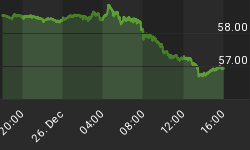Here is an extract from commentary posted at www.speculative-investor.com on31st August 2003:
Debt and the Dollar
The US Federal Government's total debt is going to increase by around $600B, or 10%, during the current fiscal year (the fiscal year ends in September). Furthermore, given that a) the cost of US involvement in Iraq looks likely to escalate, b) the Government's interest expense is going to increase as a result of the bond market's trend reversal, and c) tax revenues are more likely to fall than to rise over the next year, the increase in federal debt is likely to be even greater over the coming fiscal year. In other words, the US Government has a major budget deficit problem and this problem is likely to worsen over the next 12 months.
It makes intuitive sense to conclude that the burgeoning US Government debt will have an adverse effect on the US$. However, the below chart comparing the US Dollar's exchange value (relative to the Swiss Franc) with the year-over-year percentage change in US federal debt doesn't support this intuitive logic (note that a rising line on the chart indicates a strengthening dollar). In fact, the chart indicates that over the past 33 years there has not been a consistent correlation between the rate of increase in the federal debt and the dollar's exchange value. For example, the total federal debt soared between 1980 and 1985, a period during which the US$ was very strong. And there are other periods, such as 1995 through to the present day, when the dollar's exchange value has trended in the opposite direction to the rate of increase in federal debt.

The dollar sometimes appears to be positively correlated with the rate of increase in federal debt and negatively correlated at other times due to differences in inflation expectations. Inflation expectations peaked in 1980 and trended lower during 1980-1985, so even though the US Government spent like a drunken sailor during this period the massive spending (and the associated borrowing) was not able to counteract the major underlying trend and the US$ strengthened. In our opinion, inflation expectations bottomed over the past 12 months and are now set to trend higher over the remainder of this decade. In this environment, higher budget deficits are likely to exacerbate the major trend and lead to a weaker dollar than would otherwise have been the case.
The Trend
Many of the trends that dominated the 1990s ended in the 1999-2001 period and new trends emerged. These new trends, which include the upward trends in the prices of gold and gold stocks, the upward trend in commodity prices and the downward trend in the US$, are related to the bottoming-out and upward reversal of inflation expectations.
Although we expect the major trends that began during 1999-2001 to extend over the rest of this decade, there will be substantial counter-trend moves along the way. We are, therefore, always on the lookout for ways to determine if a large counter-trend move has begun or is about to begin.
In addition to US$ weakness (especially relative to the European currencies) and gold price strength, the past few years have been characterised by a widening yield spread (long-term interest rates have risen relative to short-term interest rates) and strength in the Swiss Franc relative to the Yen. The below charts illustrate these trends.
The first of the below charts shows the 30-year T-Bond yield divided by the 3-month T-Bill yield. Clearly, 30-year interest rates have been rising relative to 3-month interest rates since the final quarter of 2000, but notice that there has been a downturn in the ratio over the past 2 weeks. At this stage we have no reason to think that the recent downturn is anything more than a short-lived correction, but we would consider a move back below the top support line shown on the chart to be a warning sign that an important trend change was underway.
By the way, with the 3-month yield effectively capped at 1% by the Fed the only way the 30-year/3-month ratio could move back below support would be if the T-Bond yield dropped below 4.6%. This seems unlikely. Therefore, in order for the trend to change the Fed is most likely going to have to push short-term interest rates higher. This is not something that would currently be on their near-term agenda, but is something we expect will appear on their agenda within the next 6 months as a result of a further rise in inflation expectations.
The second of the below charts shows the SF/Yen exchange rate. Notice that SF/Yen has moved from the top to the bottom of its major channel over the past few months, but that the upward trend is intact. If the trend is to remain in place for at least a few more months, as we currently expect, then the SF must now start to out-perform the Yen.


















